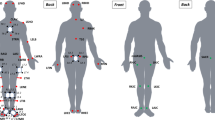Abstract
Insole pressure systems are often more appropriate than force platforms for analysing center of pressure (CoP) as they are more flexible in use and indicate the position of the CoP that characterizes the contact foot/shoe during gait with shoes. However, these systems are typically not synchronized with 3D motion analysis systems. The present paper proposes a direct method that does not require a force platform for synchronizing an insole pressure system with a 3D motion analysis system. The distance separating 24 different CoPs measured optically and their equivalents measured by the insoles and transformed in the global coordinate system did not exceed 2 mm, confirming the suitability of the method proposed. Additionally, during static single limb stance, distances smaller than 7 mm and correlations higher than 0.94 were found between CoP trajectories measured with insoles and force platforms. Similar measurements were performed during gait to illustrate the characteristics of the CoP measured with each system. The distance separating the two CoPs was below 19 mm and the coefficient of correlation above 0.86. The proposed method offers the possibility to conduct new experiments, such as the investigation of proprioception in climbing stairs or in the presence of obstacles.



Similar content being viewed by others
References
Bobbert MF, Schamhardt HC (1990) Accuracy of determining the point of force application with piezoelectric force plates. J Biomech 23:705–710. doi:10.1016/0021-9290(90)90169-4
Chapdelaine S, McFadyen BJ, Nadeau S, St Vincent G, Langelier E (2005) Instrumented staircase for kinetic analyses of upper- and lower-limb function during stair gait. Med Biol Eng Comput 43:552–556. doi:10.1007/BF02351027
Chen B, Bates BT (2000) Comparison of F-Scan in-sole and AMTI forceplate system in measuring vertical ground reaction force during gait. Physiother Theory Pract 16:43–53. doi:10.1080/095939800307601
Chesnin KJ, Selby-Silverstein L, Besser MP (2000) Comparison of an in-shoe pressure measurement device to a force plate: concurrent validity of center of pressure measurements. Gait Posture 12:128–133. doi:10.1016/S0966-6362(00)00071-0
Chockalingam N, Giakas G, Iossifidou A (2002) Do strain gauge force platforms need in situ correction? Gait Posture 16:233–237. doi:10.1016/S0966-6362(02)00017-6
Chumanov ES, Remy CD, Thelen DG (2007) Tracking the position of insole pressure sensors during walking and running. In: Proceedings from the 30th annual meeting of the american society of biomechanics, Stanford University, CA
Davis BL, Cothren RM, Quesada P, Hanson SB, Perry JE (1996) Frequency content of normal and diabetic plantar pressure profiles: implications for the selection of transducer sizes. J Biomech 29:979–983. doi:10.1016/0021-9290(95)00116-6
Forner-Cordero A, Koopman HJ, van der Helm FC (2006) Inverse dynamics calculations during gait with restricted ground reaction force information from pressure insoles. Gait Posture 23:189–199. doi:10.1016/j.gaitpost.2005.02.002
Forner CA, Koopman HJ, van der Helm FC (2004) Use of pressure insoles to calculate the complete ground reaction forces. J Biomech 37:1427–1432. doi:10.1016/j.jbiomech.2003.12.016
Hsiao H, Guan J, Weatherly M (2002) Accuracy and precision of two in-shoe pressure measurement systems. Ergonomics 45:537–555. doi:10.1080/00140130210136963
Hurkmans HL, Bussmann JB, Benda E, Verhaar JA, Stam HJ (2006) Accuracy and repeatability of the Pedar Mobile system in long-term vertical force measurements. Gait Posture 23:118–125. doi:10.1016/j.gaitpost.2005.05.008
Hurkmans HL, Bussmann JB, Selles RW, Horemans HL, Benda E, Stam HJ et al (2006) Validity of the Pedar Mobile system for vertical force measurement during a seven-hour period. J Biomech 39:110–118. doi:10.1016/j.jbiomech.2004.10.028
Lord M (1997) Spatial resolution in plantar pressure measurement. Med Eng Phys 19:140–144. doi:10.1016/S1350-4533(96)00057-4
Meyer AR, Wang M, Smith PA, Harris GF (2007) Modeling initial contact dynamics during ambulation with dynamic simulation. Med Biol Eng Comput 45:387–394. doi:10.1007/s11517-007-0166-1
Middleton J, Sinclair P, Patton R (1999) Accuracy of center of pressure measurement using a piezoelectric force platform. Clin Biomech (Bristol, Avon) 14:357–360. doi:10.1016/S0268-0033(98)00079-5
Moreno JC, Brunetti F, Rocon E, Pons JL (2008) Immediate effects of a controllable knee ankle foot orthosis for functional compensation of gait in patients with proximal leg weakness. Med Biol Eng Comput 46:43–53. doi:10.1007/s11517-007-0267-x
Putti AB, Arnold GP, Cochrane L, Abboud RJ (2007) The Pedar in-shoe system: repeatability and normal pressure values. Gait Posture 25:401–405. doi:10.1016/j.gaitpost.2006.05.010
Putti AB, Arnold GP, Cochrane LA, Abboud RJ (2008) Normal pressure values and repeatability of the Emed((R)) ST4 system. Gait Posture 27:501–505. doi:10.1016/j.gaitpost.2007.06.009
Riener R, Rabuffetti M, Frigo C, Quintern J, Schmidt G (1999) Instrumented staircase for ground reaction measurement. Med Biol Eng Comput 37:526–529. doi:10.1007/BF02513341
Schmiedmayer HB, Kastner J (1999) Parameters influencing the accuracy of the point of force application determined with piezoelectric force plates. J Biomech 32:1237–1242. doi:10.1016/S0021-9290(99)00109-8
Schmiedmayer HB, Kastner J (2000) Enhancements in the accuracy of the center of pressure (COP) determined with piezoelectric force plates are dependent on the load distribution. J Biomech Eng 122:523–527. doi:10.1115/1.1289687
Yu B, Growney ES, Schultz FM, An KN (1996) Calibration of measured center of pressure of a new stairway design for kinetic analysis of stair climbing. J Biomech 29:1625–1628
Yu W, Ikemoto Y (2007) An artificial reflex improves the perturbation-resistance of a human walking simulator. Med Biol Eng Comput 45:1095–1104. doi:10.1007/s11517-007-0255-1
Author information
Authors and Affiliations
Corresponding author
Rights and permissions
About this article
Cite this article
Fradet, L., Siegel, J., Dahl, M. et al. Spatial synchronization of an insole pressure distribution system with a 3D motion analysis system for center of pressure measurements. Med Biol Eng Comput 47, 85–92 (2009). https://doi.org/10.1007/s11517-008-0382-3
Received:
Accepted:
Published:
Issue Date:
DOI: https://doi.org/10.1007/s11517-008-0382-3




